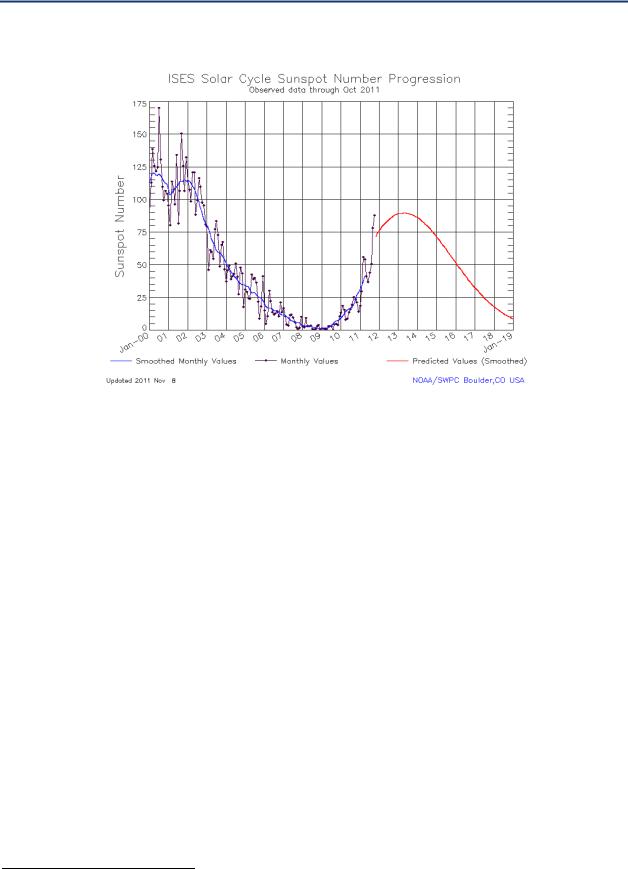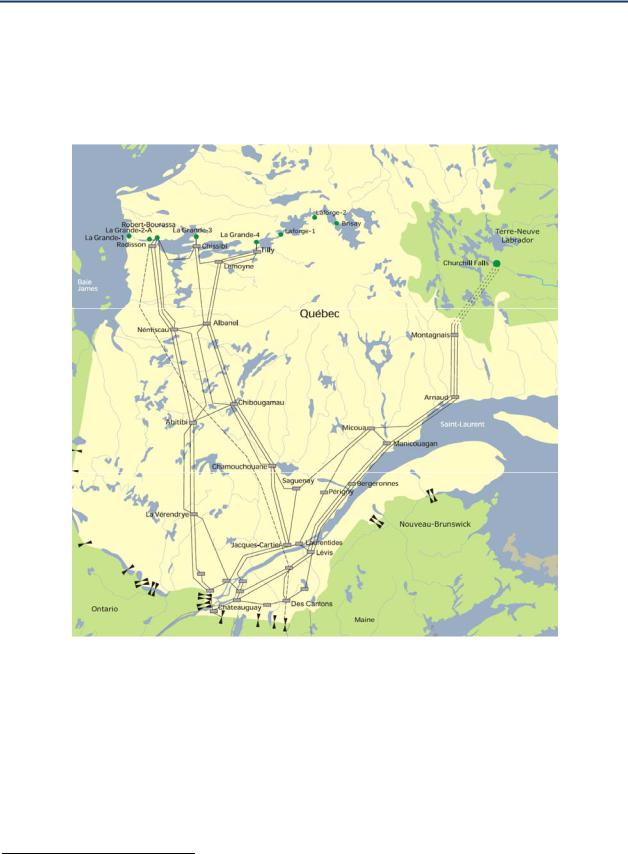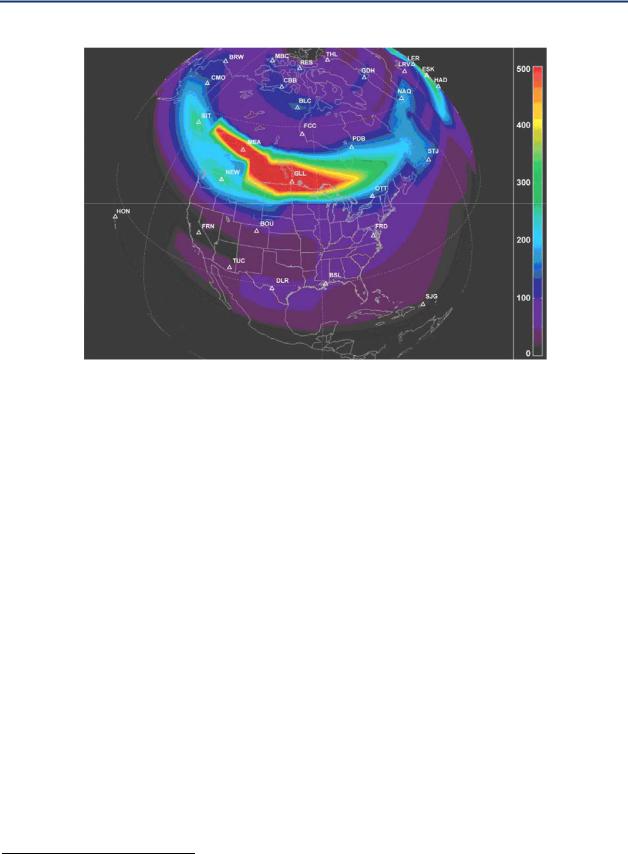
Geomagnetic_Disturbance_Task_Force_2012
.pdf
Executive Summary
There are options available for system operators and asset managers to mitigate the impact from geomagnetic disturbances. These strategies, detailed in Chapters 11 (Operating Procedures), Chapter 12 (Managing Geomagnetic Disturbance Risks), and Attachment 7 (A View on Risk Management), provide industry participants with procedures and methods that should be implemented now to better manage the risks from geomagnetic disturbances. However, the margin gained by using these system operating procedures is dependent on number of factors, including (but not limited to) equipment characteristics, system design, and operating philosophy of the asset manager.
The following conclusions are drawn from the literature included within this report:
What are the risks to operation of the bulk power system from a strong GMD?
The most significant issue for system operators to overcome a severe GMD event is to maintain voltage stability. As transformers absorb high levels of reactive power, protection and control systems may trip supporting reactive equipment due to the harmonic distortion of waveforms. In addition, maintaining the health of operating bulk power system assets during a geomagnetic storm is a key consideration for asset managers.
What transformers are at risk from a GMD?
The magnitude, frequency, and duration of GIC, as well as the geology and transformer design are key considerations in determining the amount of heating that develops in the windings and structural parts of a transformer. The effect of this heating on the condition, performance, and insulation life of the transformer is also a function of a transformer’s design and operational loading during a GMD event. This report reviews past transformer failures from strong GMD events and illustrates that some older transformer designs are more at risk for experiencing increased heating and VAr consumption than newer designs. Additionally, transformers that have high water content and high dissolved gasses and those nearing their dielectric end of life may also have a risk of failure.
What are NERC’s next steps for identifying the risks from strong GMD?
Planners and operators require the technical tools to model GIC flows and subsequent reactive power losses to develop mitigating solutions, as necessary. This tool development includes GIC flow calculations for a variety of system conditions and configurations, test waveforms representative of GMD for a variety of latitudes, and suitable transient and thermal equipment models. NERC, in collaboration with Electrical Power Research Institute (EPRI), will follow the work plan established in the recommendations section of this report. All results of will be open source and freely available. As work progresses to identify specific vulnerabilities, all assumptions and methods used for planning and operating studies need to be available, transparent, and validated through existing interconnection reliability modeling groups.
vii |
GMDTF Interim Report: Affects of Geomagnetic Disturbances on the Bulk Power System–February 2012 |

Executive Summary
I.10 Recommended Follow-on Actions for NERC
Table ES 1 identifies four high level recommended actions for NERC to respond to the conclusions documented in this report. Each of the four recommended actions below are supported by a number of separate work plan tasks, including their timeline for completion, found in Chapter 13 (Recommendations). Further, Chapter 13 also provides detailed recommendations for electric industry asset owners, government agencies, and policy makers.
Table ES 1: Recommended Follow on Actions for NERC
Improved tools for industry planners to develop GMD mitigation strategies
•NERC will support the development of equipment vulnerability assessment tools, enhance the definition of the reference solar storm, and develop open source tools and methods to enhance industry response and mitigation to the threat from a solar storm.
Improved tools for system operators to manage GMD impacts
•NERC will enhance the existing Reliability Coordinator notification procedures for GMD watches, alerts, and warnings. Further, NERC will work in partnership with industry to update reliability guidelines to provide stakeholders best practices to monitor and mitigate the impact of geomagnetically induced currents in real time operations.
Develop education and information exchanges between researchers and industry
•NERC will raise awareness of the impact of geomagnetic disturbances on the bulk power system by conducting focused training for industry and policy makers and by developing information exchanges between industry and GMD researchers.
Review the need for enhanced NERC
Reliability Standards
•NERC and the industry will investigate potential enhancements to existing NERC Reliability Standards, as well as the need for additional NERC Reliability Standards development projects, to ensure the continued reliable operation of the bulk power system in North America.
GMDTF Interim Report: Affects of Geomagnetic Disturbances on the Bulk Power System–February 2012 |
viii |

Chapter 1–Space Weather and the Power System
1.Space Weather and the Power System
1.1 Introduction
This chapter provides insights into the risks to bulk power system reliability from space weather and historical accounts of significant space weather activity.
1.2 Threat Posed by Space Weather to the Power System
Space weather is a consequence of the interaction of the sun, Earth’s magnetic field and the atmosphere. Space weather can create geomagnetic storms that affect Earth. The active elements of space weather are particles, electromagnetic energy, and magnetic fields. Terrestrial weather is local. Effects from geomagnetic storms are a global phenomenon.
The sun undergoes a 22 year cycle where the polarities of the north and south poles reverse every 11 years. Most solar storms occur during a four to six year period referred to as “solar maximum.” The next solar cycle Solar Cycle 24 is expected to reach its maximum phase in 2013 (Figure 1 shows the sunspot progression through October 2011). However, the largest historical solar storms have not occurred at the peak of the “solar maximum.” Although the probability of a solar storm occurrence is greater during the peak of the solar cycle, severe solar storms can occur at any time in the cycle.
The following is a summary of space weather phenomena and their potential effect on the bulk power system.12
1.2.1 Solar Flares
Solar flares are intense, temporary releases of energy typically occurring in “active” regions on the sun. Flares are seen as very bright areas in optical wavelengths and as bursts of noise at X ray and radio wavelengths; they can last from minutes to hours. Flares are the solar system’s largest explosive events and can be equivalent to 10 million volcanic eruptions. They radiate across the electromagnetic spectrum, from gamma rays to X rays, through visible light to kilometer long radio waves. This radiation travels at the speed of light—186,000 miles/second (300,000 kilometers/second)—so X rays, gamma rays, and radio waves are the first evidence of a flare to reach Earth. The trip from the sun takes about eight minutes. This electromagnetic radiation does not significantly impact power grid operations. Severe solar flares (i.e., level K7 or greater) occur at an approximate frequency of 175 per 11 year solar cycle, with typically eight to ten extreme flares (i.e., K8 K9) during this cycle.
12The bulk power system consists of the interconnected system of power generation and transmission facilities, as well as the control systems that operate these facilities.
1 |
GMDTF Interim Report: Affects of Geomagnetic Disturbances on the Bulk Power System–February 2012 |

Chapter 1–Space Weather and the Power System
Figure 1: The International Solar Energy Society (ISES) solar sunspot number progression through October 201113
1.2.2 Radiation Storms
Typically associated with large solar flares, radiation storms can affect Earth within 30 minutes of a major flare’s peak. During such an event, energetic solar particles (primarily protons) are released from the flare site. Some of these particles spiral down Earth's magnetic field line and penetrate the upper layers of the atmosphere. Once the upper atmosphere is penetrated, the energetic particles may produce a significant increase in the radiation environment. Radiation storms are a significant concern for satellite and space operations, but do not present a threat to the bulk power system. Strong storms only occur about 10 times per 11 year solar cycle. Severe conditions are rare, with typically three to five storms per cycle.
1.2.3 Geomagnetic Storms
Geomagnetic storms occur on Earth one to four days after a flare or other eruption occurs on the sun and direct at Earth. A CME, which is a cloud of solar material and magnetic fields that ejects from the sun and moves at a rate of about one to five million miles per hour, is usually associated with a large flare. If CMEs are Earth directed, they collide with Earth’s magnetosphere and cause geomagnetic induced current (GIC) flows that can potentially affect the operation of power system equipment (see Figure 2).14 On average, there are 200 days during the 11 year solar cycle with strong to severe geomagnetic storms and approximately four days of extreme conditions.
13NOAA/Space Weather Prediction Center Solar Cycle Progression Tracking website, last updated October 31, 2011: http://www.swpc.noaa.gov/SolarCycle/
14Equipment impacted by previous storms includes transformers, circuit breakers, generators, and protective devices.
GMDTF Interim Report: Affects of Geomagnetic Disturbances on the Bulk Power System–February 2012 |
2 |

Chapter 1–Space Weather and the Power System
Figure 2: Graphic depiction of a coronal mass ejection
Magnetosphere
Energetic
Charged Particles
Heliosphere Ionosphere
The degree to which a GMD storm impacts the power system and the power system equipment depends on a number of factors, including:
Magnitude of the magnetic field and its orientation
Latitude
Directional orientation, resistance, and length of transmission lines
Geology of the local area, including the electrical conductivity of the soil
Proximity to the ocean or large bodies of water
Design of power system and power system equipment
GMD can have had a wide range of impacts on power apparatus and power system operations. The effects on apparatus range from nuisance events, such as tripping of electrical equipment, radio interference, and control malfunctions, to large scale events, such as voltage and reactive power fluctuations, local disruption of service, limited equipment failure, and potential voltage instability resulting in uncontrolled cascading of the bulk power system.
1.3 Historical Accounts of Significant Space Weather Activity
The effects of space weather have been experienced on Earth, and in more recent history, on the bulk power system. The following are examples of such effects.
1.3.1 The Carrington Event of 1859
The largest recorded geomagnetic disturbance event was the Carrington Event of 1859. Richard Carrington, a British astronomer, observed an intense flare resulting in aurora observations as far south as Panama. The Carrington Event actually consisted of two separate solar
3 |
GMDTF Interim Report: Affects of Geomagnetic Disturbances on the Bulk Power System–February 2012 |

Chapter 1–Space Weather and the Power System
disturbances, both of which produced widespread observable auroras in North America as documented in various newspaper reports at the time (the bulk power system was not in existence in 1859).
The first magnetic disturbance started August 28, 1859. Telegraph operations were disrupted in North America and Europe from the evening of August 28 through August 29, 1859. The second disturbance began at 0440 Universal Time (UT), on September 2, 1859, and a major disturbance followed immediately.15 Telegraph operations in Europe were affected by the initial magnetic disturbance, though no effects were seen in North America for the initial disturbance as it occurred during the night when telegraphs were not operating.16
1.3.2 The 1921 Solar Storm
The May 14 15, 1921 aurora was observed from Europe, across North America, the Caribbean, and the Pacific as far west as Australia, and as far south as latitudes 30 35 degrees17 (During the maximum, the lowest latitude that the overhead (coronal) aurora was observed was 40
degrees). No report of a solar eruption is reported in the literature for this event as the establishment of the worldwide solar flare patrol did not commence until the 1930s.18,19 In the
United States, telegraph service was virtually halted near midnight on lines from the Atlantic Coast to the Mississippi River.20 This storm was reported to have “blown out fuses, injured electrical apparatus and done other things which had never been caused by any ground and ocean currents known in the past.” Telegraph communication was disrupted in cities in the northwestern United States. Some cable and telegraph lines to Alaska did not function during the storm.21
1.3.3 The 1989 Québec Blackout
At 02:44 EST, March 13, 1989, a severe geomagnetic storm (i.e., K9) causing a sudden large variation in Earth's magnetic field resulted in a blackout of the Hydro Québec system. The Hydro Québec system operates as a standalone, asynchronous system that is not part of the Eastern Interconnection (the Hydro Québec system has DC ties and radial generation into the Eastern Interconnection); therefore, this disturbance did not propagate into the Eastern interconnection from Hydro Québec.
The Hydro Québec system’s 735 kV transmission grid transfers power from hydroelectric generation in the northern part of the Province of Québec to the load area in the south
15Between 06.00 and 06.30 UT, reports of a negative magnetic field strength (H) variation of approximately 3,000 nano Teslas at Rome, New York, and a large swing in the vertical component of the magnetic (Z) field at Greenwich indicate the expansion of the auroral oval to mid latitudes
16Due to local variations in time before the introduction of Greenwich Mean Time in 1879, the occurrence occurred 5 to 6 hours after the onset in Europe
17S.M. Silverman and E.W. Cliver, “Low latitude auroras: the magnetic storm of 14–15 May 1921” Journal of Atmospheric and Solar Terrestrial Physics, Volume 63, 2001, p. 523 535: http://digitalcommons.unl.edu/cgi/viewcontent.cgi?article=1003&context=usafresearch
18Cliver, E.W., 1995. Solar activity and geomagnetic storms: from M regions and Hares to coronal holes and CMEs. Eos, Transactions of the American Geophysical Union, 76 (8), 75, 83
19AAS Meeting #194 Chicago, Illinois, May/June 1999, Session 57. A Centennial Celebration of the Life and Work of George Ellery Hale Solar, Oral, Tuesday, June 1, 1999, 10:45am 12:30pm, Continental Ballroom C
20The New York Times, 15 May 1921
21Lyman, H., 1921, Remarkable aurora of May 14–15, 1921, Monthly Weather Review 49, 406–409
GMDTF Interim Report: Affects of Geomagnetic Disturbances on the Bulk Power System–February 2012 |
4 |

Chapter 1–Space Weather and the Power System
spanning a long distance (approximately 1,000 km or 620 miles) using high voltage (735 kV) AC power lines. The power system is V shaped, with La Grande generation on the western axis, and Churchill Falls/Manicouagan on eastern axis (see Figure 3).
Figure 3: Hydro Québec transmission system
The AC network covers a large geographic area of Québec (from sub auroral to auroral zones), and most of the network rests on the Canadian Shield – a large area of low conductivity igneous rock.22 Given this low conductivity, the GICs flowed through the path of least resistance: that is the high voltage overhead transmission lines. Figure 4 shows the storm’s geomagnetic intensity.
During the geomagnetic disturbance, seven SVCs tripped within 59 seconds of each other, leading to voltage collapse of the system 25 seconds later.
22Igneous rocks (from the Greek word for fire) form when hot, molten rock (magma) crystallizes and solidifies. The melt originates deep within Earth near active plate boundaries or hot spots, and then rises toward the surface. Igneous rocks are divided into two groups (intrusive or extrusive), depending on where the molten rock solidifies. http://vulcan.wr.usgs.gov/LivingWith/VolcanicPast/Notes/igneous_rocks.html
5 |
GMDTF Interim Report: Affects of Geomagnetic Disturbances on the Bulk Power System–February 2012 |

Chapter 1–Space Weather and the Power System
Figure 4: Geomagnetic intensity–March 1989 storm
The voltage collapse and corresponding blackout of the Hydro Québec network was caused by the effects of harmonics resulting from half cycle saturation of power transformers. Unanticipated tripping of multiple SVCs and corresponding system separation were the primary causes of the issues that were experienced during the GMD event. Equipment damage was the result of temporary overvoltage caused by load shedding and system separation, and not directly by GIC flow. Among the major equipment that was damaged were two generator step up units (GSU) transformers located at La Grande 4 generating station, and a shunt reactor at Némiscau, which were reported to have suffered dielectric damage due to overvoltage when the system separated. The SVCs at Albanel and Némiscau suffered only minor damage. The SVC phase C transformer at Chibougamau substation was also damaged by temporary overvoltage following system separation. Surge arrester failures were also reported.23 Additional details on this event are included in Chapter 6.
1.3.4 The 2003 Halloween Solar Storms
The largest recent storm was during Solar Cycle 23,24 which began in May 1996 and peaked in April 2000. Seventeen major flares erupted on the sun between October 19, 2003, and November 5, 2003 (often called the 2003 Halloween Solar Storms). A wide range of effects on human activities and technological systems were observed. The most extensively reported effects resulted from the interaction of energetic particles with spacecraft operations and electronics. A number of specific deep space missions and near Earth satellites were also affected.25 Airline routes and schedules were significantly affected due to communication degradation in the daylight and Polar Regions and concerns about increased radiation exposure at high latitudes.
23NERC report, “March 13, 1989 Geomagnetic Disturbances” http://www.nerc.com/files/1989 Quebec Disturbance.pdf
24Solar cycles typically last approximately 11 years in duration from trough to peak in activity.
25United States National Oceanic and Atmospheric Administration (NOAA) magazine: http://www.magazine.noaa.gov/stories/mag131b.htm
GMDTF Interim Report: Affects of Geomagnetic Disturbances on the Bulk Power System–February 2012 |
6 |

Chapter 1–Space Weather and the Power System
The electric power industry in North America experienced some effects. Impacts and actions reported by grid operators included high levels of neutral current, a capacitor trip in the Pacific Northwest (known to be GIC susceptible), and some transformer heating in the eastern United States.26
GIC impacts were more significant in Northern Europe. On October 30, 2003, a three phase large power transformer in the power grid in the south of Sweden was subjected to GIC flows estimated to be in the 330 amps. A blackout that ranged in duration between 20 and 50 minutes followed that resulted from tripping of a 130 kV line. The line trip was caused by the operation of a relay with a higher sensitivity to the third harmonic associated with the transformers half cycle saturation. No transformer issues were reported to be associated with this GIC storm.
26 United States National Oceanic and Atmospheric Administration (NOAA) Space Weather Prediction Center (SWPC) assessment of 2003 Halloween Storm Outbreak: http://www.swpc.noaa.gov/Services/HalloweenStorms_assessment.pdf
7 |
GMDTF Interim Report: Affects of Geomagnetic Disturbances on the Bulk Power System–February 2012 |

Chapter 2–Monitoring and Predicting Space Weather
2.Monitoring and Predicting Space Weather
2.1 Introduction
In the United States, the responsibility for monitoring and providing services on space weather rests with the Space Weather Prediction Center (SWPC), located in Boulder, Colorado.27 The SWPC is part of the National Oceanic and Atmospheric Administration (NOAA) of the Department of Commerce. SWPC provides real time monitoring and forecasting of solar and geophysical events that affect satellites, power grids, communications, navigation, and many other technological systems. SWPC is also the primary warning center for the International Space Environment Service28 (ISES) and works with national and international partners to share data, products, and services. Further, magnetometers are operated by the United States Geological Survey (USGS), which operates the National Geomagnetism Program monitoring Earth’s magnetic field at magnetic observatories and distributes magnetometer data in real time.29
In Canada, the Canadian Space Weather Forecast Centre30 (CSWFC), located in Ottawa, Ontario, is responsible for monitoring and providing services on space weather. The CSWFC is part of Natural Resources Canada (NRCan).31 Similar to the SWPC in the United States, the CSWFC provides forecast services to various operating entities within Canada. Also, similar to the SWPC, the CSWFC is a primary warning center for the ISES. Another NRCan affiliate, the Geological Survey of Canada32 (GSC) operates a network of 15 magnetic observatories, which use magnetometers to gather data on Earth’s geomagnetic field. Satellites and Earth based observation sites monitor solar activity to detect active regions, solar flares and other events. The information is used by NRCan scientists, who work with several Canadian universities, the Canadian Space Agency,33 and the National Research Council34 to provide near real time forecasting of space weather events through the Space Weather Canada website.
27The NOAA Space Weather Prediction Center can be accessed at: http://www.swpc.noaa.gov .
28The International Space Environment Service (ISES) is a permanent service of the Federations of Astronomical and Geophysical Data Analysis Services under the support of the International Union of Radio Science (URSI) in association with the International Astronomical Union (IAU) and the International Union of Geodesy and Geophysics (IUGG). http://www.ises spaceweather.org/
29 The USGS National Geomagnetism Program: http://geomag.usgs.gov/
30The Canadian Space Weather Forecast Centre at Space Weather Canada can be accessed at: http://www.spaceweather.ca/index eng.php
31 Natural Resources Canada can be accessed at: http://www.nrcan.gc.ca/home
32The Geological Survey of Canada is a part of the Earth Sciences Sector of Natural Resources Canada.: http://gsc.nrcan.gc.ca/index_e.php
33Established in March 1989, the Canadian Space Agency (CSA) was created through an Act of the Canadian Parliament in December 1990: http://www.asc csa.gc.ca/eng/about/default.asp
34The National Research Council’s mission is to improve government decision making and public policy, increase public understanding, and promote the acquisition and dissemination of knowledge in matters involving science, engineering, technology, and health. The Research Council's independent expert reports and other scientific activities inform policies and actions that have the power to improve the lives of people in the U.S. and around the world. http://www.nationalacademies.org/nrc/
GMDTF Interim Report: Affects of Geomagnetic Disturbances on the Bulk Power System–February 2012 |
8 |
